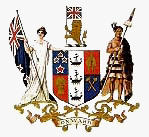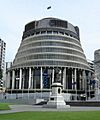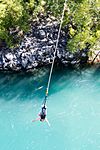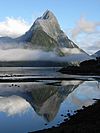National symbols of New Zealand facts for kids
National symbols of New Zealand are used to represent what is unique about the nation, reflecting different aspects of its cultural life and history.
Official symbols
| Symbol | Image | Adopted | Remarks | |
|---|---|---|---|---|
| Flag | Flag of New Zealand |  |
24 March 1902 | A Blue Ensign with the Southern Cross of four white-edged red five-pointed stars centered on the outer half of the flag. |
| Coat of arms | Coat of arms of New Zealand | 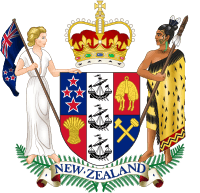 |
The coat of arms of New Zealand is the official symbol of New Zealand. The current version was granted by Queen Elizabeth II in 1956. | |
| National anthems | "God Defend New Zealand" "God Save the Queen" |
"God Defend New Zealand" was adopted in 1977. | Both are official, though in most circumstances "God Defend New Zealand" is used as the anthem. "God Save the Queen" is mostly used as the royal anthem. | |
| National colours | Black, red ochre and white/silver |  |
New Zealand national honours have used red ochre, black and white/silver since 1975. The national Māori flag, official since 1990, also uses these colours with attached symbolism. | Red ochre (kokowai) has a spiritual significance in Māori culture, associated with life and vitality. |
Unofficial emblems
| Symbol | Image | Remarks | |
|---|---|---|---|
| National bird | Kiwi (Apteryx mantelli) | 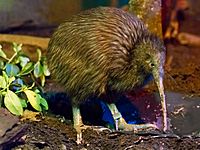 |
The term Kiwis has been used as a nickname for New Zealanders since at least World War I, and the bird's use as a symbol for the country dates from the same era. |
| National plant | Silver fern (Cyathera dealbata) | 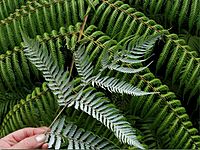 |
A species of medium-sized tree fern, endemic to New Zealand. Often referred to by its Māori name, ponga, the silver fern has been used to represent New Zealand since the 1880s. |
| National flower | Kōwhai (Sophora tetraptera) | 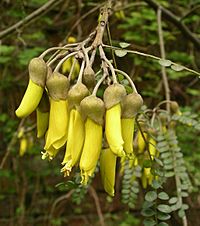 |
Evergreen tree, producing bright yellow flowers in spring. Blooms of kōwhai are found throughout New Zealand in a diverse range of habitats. The Department of Conservation notes that kōwhai is widely regarded as being the national flower. |
| National personification | Zealandia | 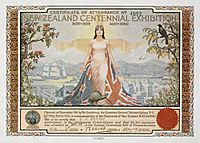 |
Popular in the late 19th and early 20th century. Now rarely used, other than as a supporter on the coat of arms. |
Cultural icons
Icons of New Zealand culture are almost as well known by New Zealanders and visitors as unofficial symbols. Certain items of popular culture thought to be unique to New Zealand are also called "Kiwiana".
| Image | Remarks | |
|---|---|---|
| The All Blacks | 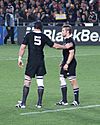 |
The country's national rugby union team - three times world champions, and the country's best known sports team both locally and internationally. |
| The Beehive | The distinctly shaped executive wing of New Zealand Parliament Buildings, built in the 1970s. | |
| Bungy jumping | Popularised by A.J. Hackett in the South Island, it has become a popular extreme sport worldwide. | |
| Haka | A traditional Māori war dance, now widely used by sports teams as a challenge and by schools as a tribute or honour. | |
| Hei-tiki | Traditional Māori ornamental pendants. | |
| Kiwifruit | This fruit was branded kiwifruit when growers in New Zealand established successful cultivars suitable for export. It remains a major export for the country. | |
| Koru | The koru, widely used in traditional Māori art, is a stylised depiction of an unfurling silver fern frond. | |
| The Lord of the Rings | The film trilogy (and the subsequent The Hobbit trilogy) highlighted New Zealand's natural scenery and is widely associated with the country worldwide. | |
| Mitre Peak | A distinctive peak which dominates Milford Sound, one of the country's most popular tourist destinations. | |
| Pāua | A species of abalone. Its flesh is a delicacy, and its iridescent shell is used for ornamentation. | |
| Pavlova | A meringue cake with a crisp crust and soft, marshmallow centre, topped with whipped cream and fruit. Its country of origin is widely contested by Australia. | |
| Pounamu ("Greenstone") | 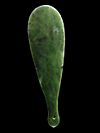 |
Nephrite jade, highly valued by Māori both physically and spiritually. |
| Sky Tower | Opened in 1997, the Sky Tower is the tallest freestanding structure in the Southern Hemisphere. |

All content from Kiddle encyclopedia articles (including the article images and facts) can be freely used under Attribution-ShareAlike license, unless stated otherwise. Cite this article:
National symbols of New Zealand Facts for Kids. Kiddle Encyclopedia.

